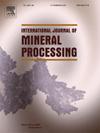Triboelectrostatic separation of pulverized fuel of coal power plant based on mineralogical analyses
Abstract
Associated minerals in the raw coal increase the energy consumption and abrasion of grinding media of vertical spindle pulverizer (VSP). Moreover, the low separating efficiency of classifier in VSP leads to the return of fines to grinding table, worsens the grinding phenomenon and make the energy-size reduction of coal complex. Beneficiation of fines rejected by classifier is helpful to save energy and decreases the air pollution caused by the combustion of minerals in fines. Aiming to evaluate the potential for beneficiating the circulating loads, multi-analytical techniques are utilized to the raw coal and ground products. Phase composition analyses of raw coal show that kaolinite is the main mineral. Comparison of scanning electron microscopy and energy dispersive X-ray spectroscopy (SEM-EDX) of coal before and after comminution illustrates the liberation of kaolinite from coal substance, and the measurement of charge-mass ratios indicates the opposite polarity of tribocharge between coal and minerals, which indicates the separating possibility based on difference in the electric physics. Removal results of minerals from circulating loads by the triboelectrostatic separator vary with product fineness and liberation degrees. The best separation result is obtained on the finest progenies produced with the yield and ash content of clean coal at 61.95% and 18.92%, respectively.

 求助内容:
求助内容: 应助结果提醒方式:
应助结果提醒方式:


